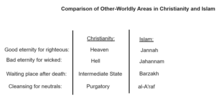Araf (Islam)

In Islam, al-A'raf (Arabic: الأعراف) is a separator realm or borderland between Jannah (heaven) and Jahannam (hell),[2] inhabited by those who are evenly balanced in their sins and virtues, they are not entirely evil nor are they entirely good. This place may be described as a kind of benevolent purgatory with privation but without suffering. Some hadith depict that rather than this place being a middle ground purgatory in between Heaven and Hell, it is actually just the top layer of Hell, the least severe layer.
The word is literally translated as "the heights" in English. The realm is described as a high curtain between hell and paradise.[3] Ibn Kathir described A'raf as a wall that contains a gate.[4] In this high wall lived people who witness the terror of hell and the beauty of paradise. They yearn to enter paradise, but their sins and virtues are evenly balanced. Yet with the mercy of God, they will be among the last people to enter the paradise.[4]
A'raf is described in the Quran in sura Al-A'raf, 46–47.
Al-A'raf has some similarities to the Christian concept of Purgatory. Al-Haafith Al-Hakami said about the people of Al-A‘raaf, "They will be kept between Paradise and Hell for a period of time that Allaah wills, then they will be allowed to enter Paradise." [5]

See also
References
- ^ Begley, Wayne E. The Garden of the Taj Mahal: A Case Study of Mughal Architectural Planning and Symbolism, in: Wescoat, James L.; Wolschke-Bulmahn, Joachim (1996). Mughal Gardens: Sources, Places, Representations, and Prospects Dumbarton Oaks, Washington D.C., ISBN 0884022358. pp. 229–231.
- ^ "An Exegical Study of Qur'anic Term Al-A`raf". Archived from the original on 2022-11-05. Retrieved 2014-12-01.
- ^ Questions on Islam - Who are the companions of Araf, which is mentioned in the Surah Al-Araf?
- ^ a b The People of Al-A'raf
- ^ "Definition and destiny of the people of Al-A'raaf". www.islamweb.net. Retrieved 2024-04-16.